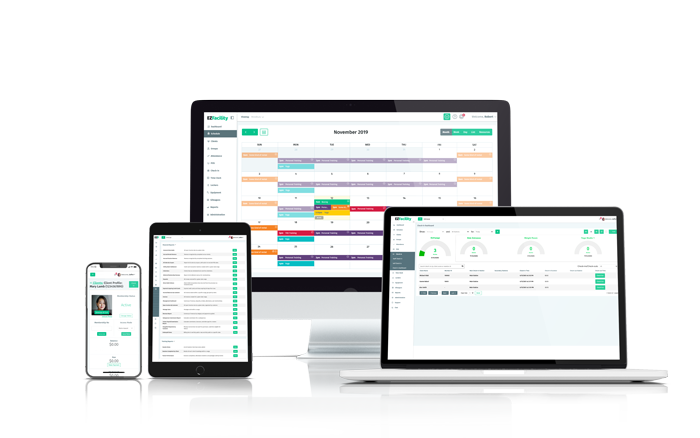Running a successful fitness business takes more than passion and programming. From managing memberships to scheduling classes and staying on top of payments, the operational side of a gym can quickly become overwhelming, especially as your business grows.
That’s where gym software comes in, however, not all platforms are built the same.
A strong gym management system takes the pressure off your daily tasks, helps you retain more members, and creates space for growth. The best platforms do more than simplify. They drive progress by streamlining operations and building stronger connections with your community.
This guide breaks down the key features to look for in gym software, shows how they impact real fitness businesses, and explains how EZFacility delivers where it counts.
What Is a Gym Management System?
What Are the Must-Have Gym Software Features?
How to Choose the Right Gym Software for Your Business
How EZFacility Delivers on What Matters Most
Choose Gym Software That Supports Growth and Community
Book an EZ Facility Demo Today
What Is a Gym Management System?
The ideal gym management system brings everything together in one place: scheduling, memberships, billing, reporting, and communication, so your team can stay organised and focused.
Instead of juggling spreadsheets, manual admin, and disconnected tools, you get a single, streamlined platform that acts as the operational core of your business.
With the right system, you also gain deeper insight into member behaviour and business performance, helping you make more informed, strategic decisions.
The most effective gym management platforms create smoother workflows, enhance the member experience, and give you back time to focus on what matters most: building a strong, engaged fitness community.
What Are the Must-Have Gym Software Features?
Here are the must-have gym software features that drive retention, revenue, and stronger client relationships:
| Feature | What It Does | Business Outcome |
|---|---|---|
| Facility Scheduling | Manage classes, rentals, and appointments in one place | Fewer conflicts, smoother operations, happier members |
| Membership Management | Automate renewals, freezes, upgrades, and contracts | Higher retention, less manual admin |
| POS and Billing | Track retail sales, process payments, and manage inventory | Increased revenue and real-time visibility |
| Branded Mobile App | Offer self-service booking, payments, and communication | Improved engagement and brand loyalty |
| Client Portal | Let members update profiles, manage packages, and check in | Reduced staff workload and better user experience |
| Marketing Tools | Send targeted email/SMS campaigns and promotions | Stronger relationships and increased member retention |
| Payroll & Commission Tracking | Automate staff compensation by hours, sessions, or sales | Fewer payroll errors and more motivated staff |
| Reporting & Analytics | Track attendance, revenue, and membership trends | Data-driven decisions for growth and efficiency |
| Hybrid & On-Demand Features | Support livestream classes and video libraries | More flexible options, better retention, broader reach |
Below, we break down each of these features in more detail, including real-world examples to demonstrate how they can make a positive impact on your fitness business.
#1 – Facility Scheduling and Management
A powerful scheduling tool allows you to manage classes, personal training sessions, and facility rentals all in one place. Members can book time slots easily, and staff can view and adjust schedules without confusion.
Real-world example: A boutique gym offering yoga classes uses facility scheduling software to manage instructor availability and room bookings. This minimises double-bookings, improves staff coordination, and makes scheduling seamless for members.
Business outcome: Fewer scheduling errors, better staff communication, and a smoother experience for members.
#2 – Membership Management
Your software should track memberships, automate renewals, manage freezes or cancellations, and offer flexible options like family accounts or tiered memberships.
Real-world example: A fitness studio uses automated membership management to remind clients of expiring contracts and process renewals without manual follow-up, saving hours of administrative work each month.
Business outcome: Higher renewal rates and less time spent chasing down expired memberships.

#3 – POS and Inventory Management
A built-in point-of-sale system enables your gym to sell merchandise, supplements, and add-on services while managing inventory levels in real time.
Real-world example: A gym that sells branded apparel and protein shakes uses integrated POS features to track inventory, so they never run out of popular items or miss out on additional revenue.
Business outcome: Increased retail sales and better stock control.
#4 – Branded Mobile App
A mobile app customised to your gym’s brand lets members book classes, track workouts, communicate with trainers, and manage their accounts conveniently from their phones.
Real-world example: A multi-location gym chain offers a branded app where members can book sessions, receive push notifications for promotions, and view their progress.
Business outcome: Improved member engagement and brand loyalty.
#5 – Self-Service Client Portal
Empowering members to manage their profiles, payments, bookings, and goals through a self-service portal saves staff time and improves member satisfaction.
Real-world example: A studio specialising in HIIT classes allows members to update billing details, book classes, and check in using a client portal.
Business outcome: Reduced administrative workload and a better member experience.
#6 – Marketing and Communication Tools
Your software should include specialised marketing tools. These should allow for targeted email campaigns, SMS notifications, and promotions to drive engagement and retention.
Real-world example: A Pilates studio uses automated birthday messages and membership anniversary emails to build stronger member relationships.
Business outcome: Higher member retention through personalised communication.
#7 – Payroll and Commission Tracking
Software that calculates payroll and commissions automatically helps you pay staff accurately based on classes taught, sales made, or hours worked.
Real-world example: A personal training gym uses built-in payroll tracking to compensate trainers based on sessions completed and merchandise sold.
Business outcome: Fewer payroll errors and more motivated staff.

#8 – Reporting and Analytics
Data-driven reporting helps you understand member trends, financial health, and operational performance so you can make informed decisions.
Real-world example: A growing gym uses analytics to identify the most popular classes and optimise their schedule to boost attendance.
Business outcome: Smarter scheduling, better program offerings, and stronger profitability.
#9 – Hybrid and On-Demand Fitness Features
Modern gym software should support training that extends beyond the gym floor. Livestream scheduling, Zoom integration, and on-demand video libraries make it easy for members to stay consistent both in person and online.
Real-world example: A boutique studio runs both in-person and livestream yoga classes, giving members the freedom to choose how they attend while keeping scheduling and payments centralised.
Business outcome: Increased member flexibility, improved retention, and a stronger offering for hybrid and remote clients.
How to Choose the Right Gym Software for Your Business
Choosing gym software isn’t a box-ticking exercise. It’s about finding a platform that fits your business, supports your growth, and helps you build stronger connections with your members. Get it right, and you’ll spend less time managing systems and more time building a gym your community truly values.
Different types of fitness businesses have different needs, so your software priorities should reflect your operational focus.
The goal is to match your immediate needs without limiting future expansion. A platform that can grow with you removes the stress of migrating systems later.
Studios and Independent Gyms
Flexibility is key. Look for membership tools that adapt to your pricing and packaging, simple class scheduling, and built-in support for payments and promotions. A branded app and client portal can elevate the experience and keep your brand front and centre.
Multi-location Facilities
You’ll need features built for scale. Think multi-site scheduling, centralised member data, shared reporting, and custom-branded digital tools. Consistent systems across locations improve efficiency and help retain members.
Sports and Leisure Centres
Look for software that supports complex bookings for pitches, courts, and halls, alongside group registration and tools for managing leagues or tournaments. These features help keep operations smooth and members engaged.
Solo Professionals (PTs and Instructors)
Prioritise tools that simplify scheduling, streamline payments, and make client communication easy. Choose a system that supports your current setup but has the flexibility to grow with you.

Questions to Ask in a Demo
A demo is your opportunity to dig deeper and find out how the software performs in real-world gym scenarios. Don’t hesitate to ask specific, practical questions like:
- How easy is it for a new member to sign up and book a session?
- Can we automate billing, renewals, and communication sequences?
- How does the reporting dashboard help track retention and revenue?
- What branding options are available for apps and client portals?
- What happens if we expand to a second or third location?
Focus on how the system improves operational efficiency, supports community engagement, and scales with growth rather than getting distracted by surface-level features.
How EZFacility Delivers on What Matters Most
EZFacility is built for fitness and sports businesses that want to run smarter, engage members better, and grow with confidence. From scheduling and payments to reporting and communication, it brings your operations under one roof so nothing falls through the cracks.
Run Your Business Smoothly, Every Day
Manage classes, appointments, and rentals with flexible scheduling tools that work across locations. Automate billing, track memberships, and handle contracts with less admin and fewer errors. The built-in POS makes it easy to sell products or services while managing inventory in real time.
And with 99.99% uptime, AWS hosting, PCI DSS Level 1 compliance, and personalised onboarding support, EZFacility gives you a secure, stable foundation you can trust.
Make It Easy for Members to Stay Engaged
Give members the freedom to manage bookings, payments, and profiles through a branded app or client portal. With either a custom-branded experience or the included MemberME+ option, they stay connected and in control. Keep engagement high with targeted emails, push notifications, and SMS updates, all built into the platform. You can also create personalised campaigns using AI-assisted email tools.
Support Your Team and Streamline the Back Office
Track payroll and commissions automatically based on hours worked, sessions delivered, or sales completed. Staff can access their schedules and performance metrics, while managers can oversee everything from a central dashboard. No spreadsheets or guesswork required.
Get Clarity on What’s Working (and What’s Not)
Access real-time reporting on class attendance, revenue, retention trends, and more to guide smarter operational decisions. These insights help you optimise scheduling, staffing, and strategy across the board.
Build a Stronger Fitness Community
Keeping members engaged goes beyond great workouts. It’s about helping them feel connected, motivated, and part of something bigger.
EZFacility includes tools for goal tracking, referrals, achievement badges, and event management that are designed to celebrate progress, reward loyalty, and encourage friendly competition. These features build a stronger sense of community and help members stay active, accountable, and committed for the long haul.
You can run transformation challenges, launch referral campaigns, and celebrate milestones – all from one central platform.
Choose Gym Software That Supports Growth and Community

Your business won’t stay the same, and your gym software shouldn’t either. You need a system that adapts as you grow, supports daily operations without friction, and gives you the tools to build a thriving, connected community.
EZFacility brings everything together in one system, backed by personal onboarding, powerful automation, and tools built for real-world fitness and sports businesses.
Gym Software Feature FAQs
1. What features should I look for in gym software?
Look for features like class scheduling, membership management, billing and payments, reporting, marketing tools, and a branded member app. These tools help you run your business more efficiently while improving member experience.
2. Can gym management software handle hybrid or online classes?
Yes. Many modern gym platforms support livestreaming through Zoom and offer on-demand video libraries so you can run hybrid classes and serve remote members.
3. Does gym software include billing and payment processing?
Most gym software includes payment tools, but quality varies. Look for integrated billing systems that support direct debits, credit card payments, and recurring billing — all in a secure, compliant environment.
4. Can I use gym software across multiple locations?
Some platforms support multi-site scheduling, reporting, and member data management. This is essential for growing fitness businesses and franchises.
5. How do branded mobile apps work with gym software?
A branded app gives members an easy way to book classes, manage their accounts, and engage with your gym — all from their phone. Some platforms also offer a generic app for businesses on a smaller budget.
6. Does gym software help with member retention?
Yes. Features like automated email reminders, referral tracking, progress milestones, and community-building tools can all help keep members engaged and coming back.
7. Can gym software automate staff payroll and commissions?
Many platforms include tools to track trainer hours, sessions delivered, and retail sales, then calculate payroll and commissions automatically.
8. Is gym software secure and reliable?
Look for software hosted on enterprise platforms like AWS, with compliance certifications like PCI DSS. Uptime and customer support are also key factors to evaluate.
9. How easy is it to switch to a new gym management system?
Switching is easier with providers that offer personalised onboarding, data migration support, and 1:1 training sessions so you’re not left figuring it out alone.
10. What makes EZFacility different from other gym software?
EZFacility combines class and rental scheduling, billing, branded apps, league management, and hybrid delivery, all backed by hands-on onboarding and support. It’s built to scale with gyms, studios, and sports centres.
Book an EZ Facility Demo Today
Ready to see it in action? Book a demo now and discover how EZFacility can help you streamline your operations, support your team, and grow with confidence.










